Breeding the Banggai Cardinalfish in your Home Aquarium
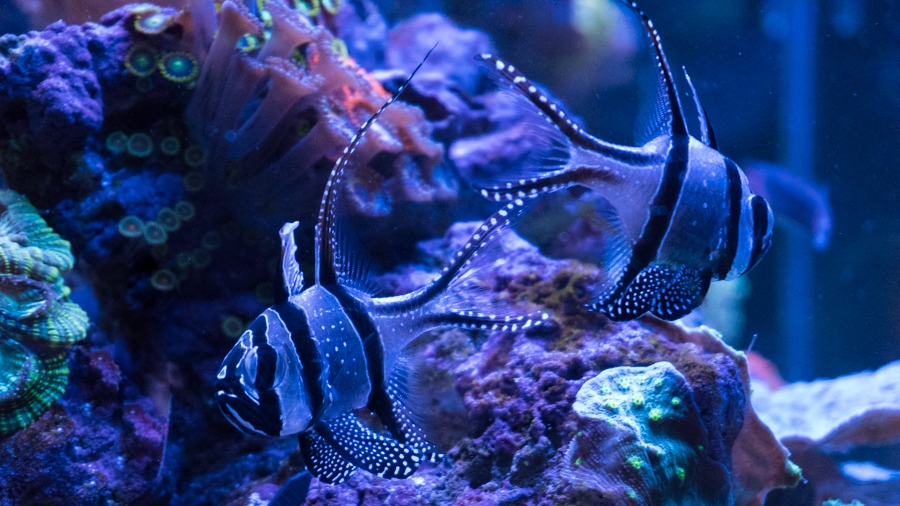
Introduction
The Banggai Cardinalfish or Pterapogon kauderni is a species of cardinalfish endemic to a small area of Central Sulawesi Indonesia around the coasts of 33 islands in the Banggai Archipelago. They are a striking, hardy, disease resistant fish making them a great choice for aquariums. They can be kept singly or in a mated pair as once sexually mature they are no longer tolerant of conspecifics. They are an excellent community fish leaving all other fish, coral and invertebrates alone and will even be hosted by long-spined sea urchins (Diadema antillarum) as well as various corals and anemones. Due to their demand, limited distribution in the wild, and the ease of raising their fry they are an excellent choice for captive breeding. They form non-monogamous pairs with the females willing to mate with multiple males. The following is my personal experience with breeding these amazing fish in my home aquarium over the past three years.
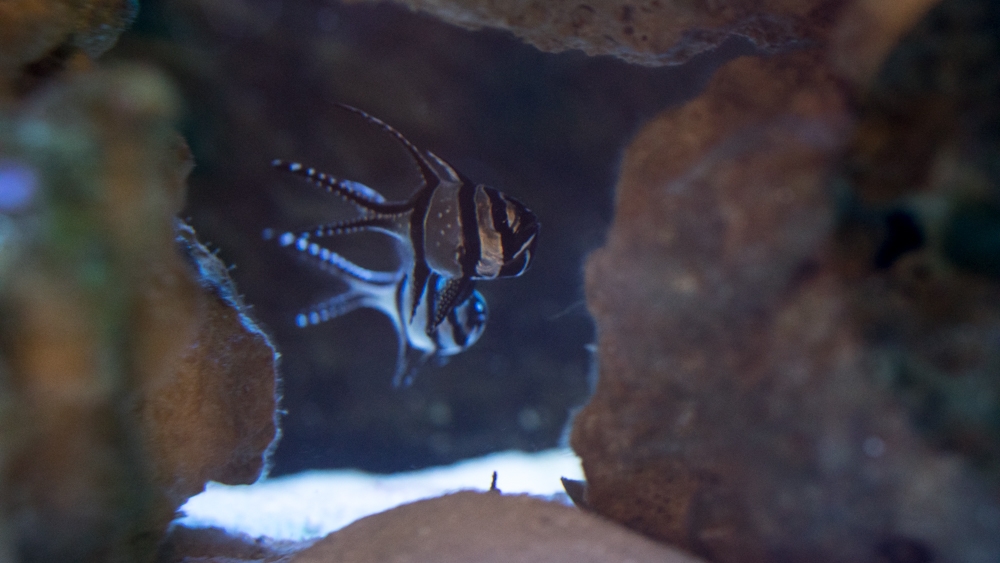
Getting a Mated Pair and Encouraging them to Breed
The Banggai Cardinalfish lacks any easily visible sexual dimorphism when young but develops some differentiating characteristics once mature such as males having a larger more “bull dog” looking mouth as well as growing longer second dorsal fins and broader pelvic fins. The easiest way for the average hobbyist to get a mated pair is to purchase 4-5 fish and let them form pairs on their own. Once you see a pair form you can re-home the remainder of fish. There is however another way. Between the pelvic and anal fins there will be either one or two small vents. Females having one vent and males having two. These vents are exceptionally hard to see when young but if you look closely you may be able to see them, feeding heavily will help the vents become more visible. Taking photos or video with a DSLR camera and macro lens can also help. See the photos below, single vent on the female (left) and two vents on the male (right).
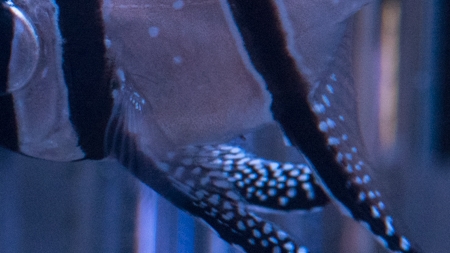
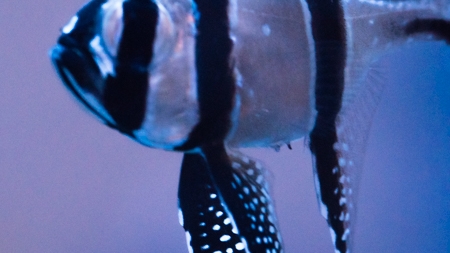
There is no secret to getting them to breed. Give them a quality diet and an appropriately sized and maintained aquarium and they will reward you with a new fry every 2-4 weeks. When the female is ready to transfer the egg sack she starts following the male closely and starts vibrating on his side then on the other. While the male shows his readiness by flaring out his mouth. They will do this on and off for some time and then in a flash the egg sack is quickly fertilized and transferred to the safety of the males mouth.
The male will hold the eggs anywhere from 23-30 days and release anywhere from 10-20 fry at a time. Once the male is holding the eggs the female will become more territorial and protect the male. Even when the male is not holding the females tend to be more aggressive but when he is holding this behavior is exaggerated.
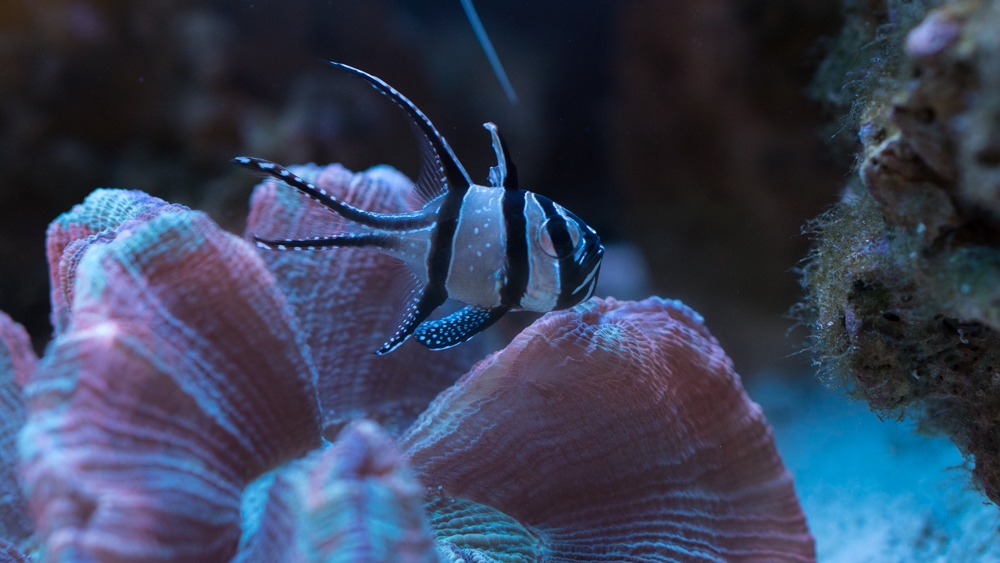
Collecting the Fry
When the male is close to releasing I put in a several fake sea urchins made of epoxy and zip tie clippings and remove mechanical filtration as well as making sure all pumps have foam guards to prevent fry from getting sucked into pumps. Alternatively you could somehow prevent them from entering the sump but all methods I tried restricted the flow and it was ultimately easier to just remove the socks and rescue any that ended up down there. You'll know he's close because you will see the little baby fish trying to push their way out of the male's mouth in the days before he lets them go as seen below.
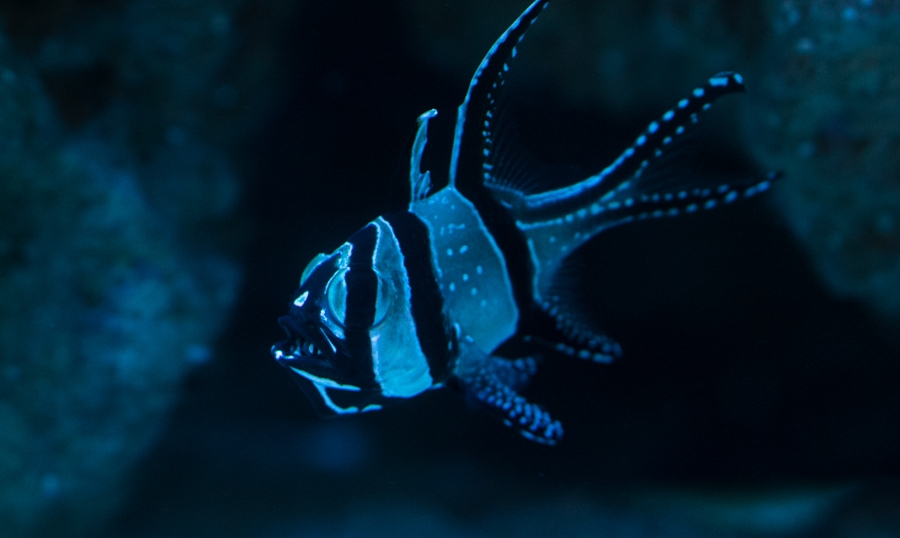
The male will tend to release the fry in the hours before the lights turn on or just after they’ve turned off. The fry will tend to go to the sea urchins and especially the ones in lower flow areas. The sea urchins provide shelter from predatory fish and groups them together for you to easily collect. On several occasions I've turned the flow off and been able to just slowly lift the sea urchin up and the fry will travel up with the urchin, then I just put a net under and slowly lift them out, setting the fake urchin aside once out of the water.
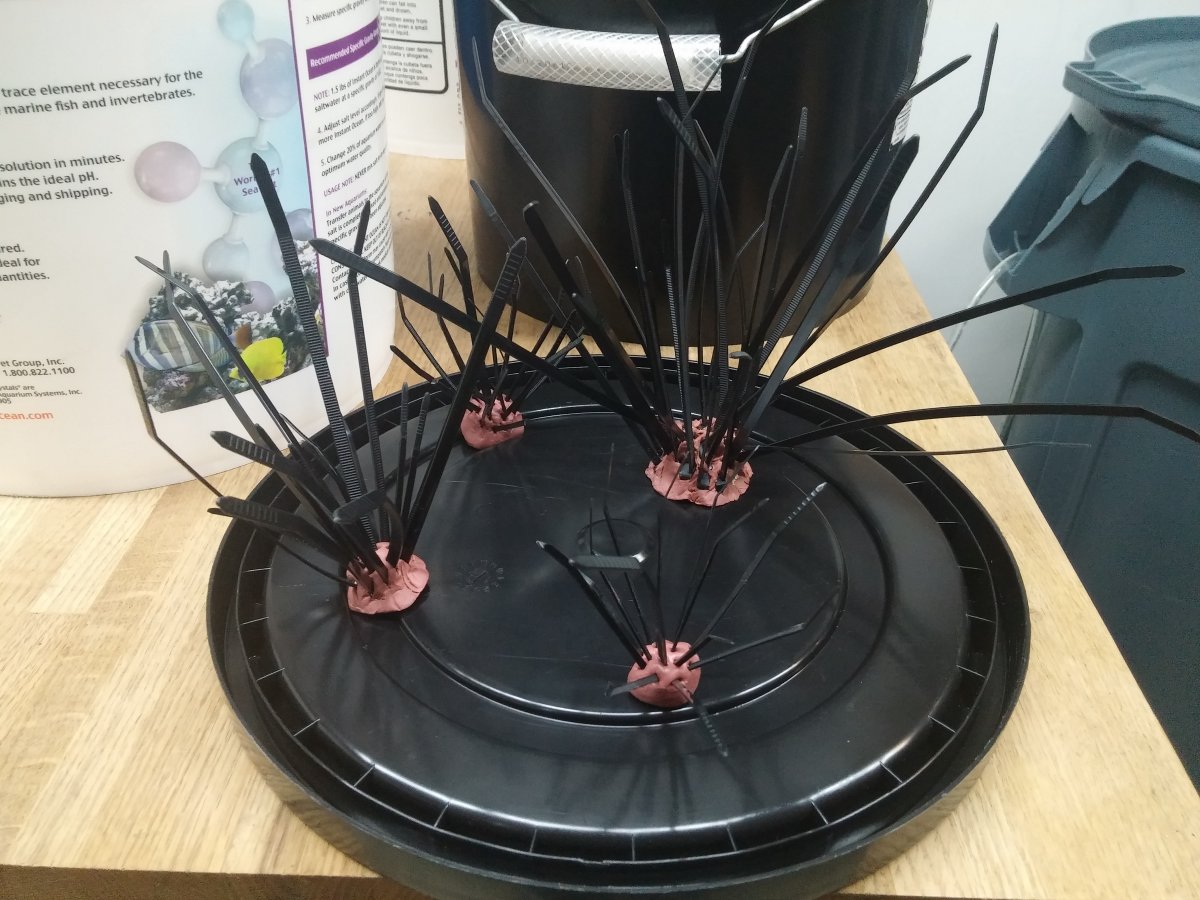
(Fake sea urchins made of epoxy and zip tie clippings)
I check just after lights out, in the middle of the night if I'm up, and first thing in the morning every day until they are all released. Also, it's common for fry to be released over the course of a couple or a few days so don't assume he's empty until you see him eat again. As he releases them I snatch them up with a small net trying to damage as few corals as possible. A bright flashlight after lights out will be key with this method. And I put them into either a breeder net or a Tupperware with slits cut into it, just enough to provide some flow but not large enough for them to escape. I keep them in there for the first couple weeks or so before transferring to a 10 or 20 gallon of their own. While the fake sea urchin method is effective for display reef systems a dedicated breeding system for just the Banggai pair and their fry is obviously ideal.
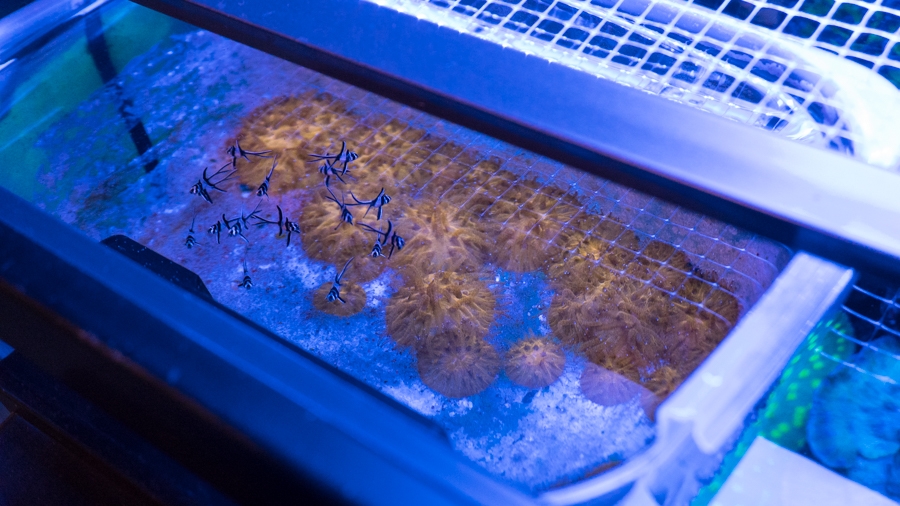
(Baby Banggais with tiny Fungia corals in a Tupperware)
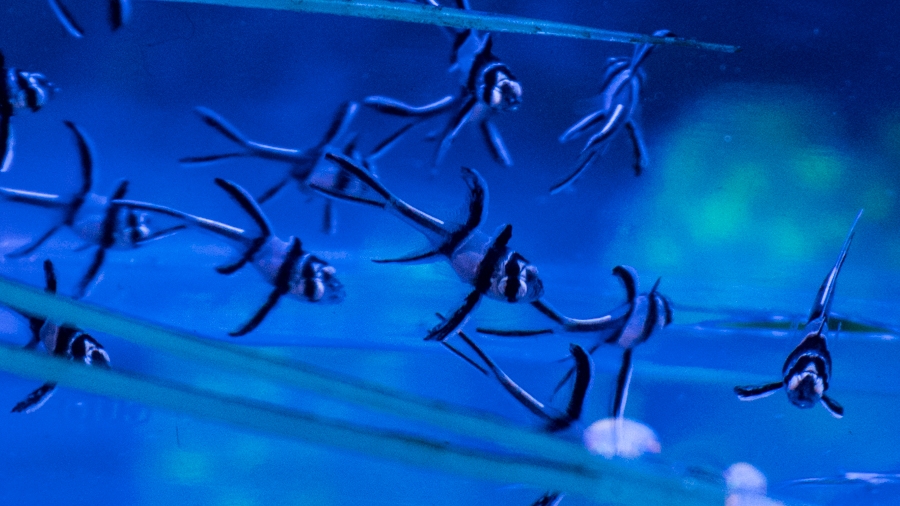
Feeding the Fry
Once released the fry will readily eat Artemia nauplii (Baby Brine Shrimp) and culturing them was the easiest way I found to keep the fry fed. It's important to note however that Artemia alone is not the best source of nutrition so you should enrich the Artemia with Selcon and its included HUFA's. The newborn fry will be prone to shock events known as “Sudden Fright Syndrome”. When shocked by the lights turning on or some other stressor they will sink to the bottom of the tank and lay on their side often times breathing heavy and will sometimes die from the ordeal. The supplementation of HUFA’s to their diet will decrease sudden fright syndrome occurrences and dramatically decrease or prevent mortality from those instances. In my case it was dramatic, before I started enriching I would lose 1-2 from each fry and have several sudden fright syndrome episodes. But early on I found out I could enrich the Artemia. After I started enriching my Artemia, I did not lose a single one for the remainder of the time I bred these fish and did not observe any episodes of sudden fright syndrome. Artemia will hatch in 12-24 hours depending on temperature, hatching faster when kept at a higher temperature. I found any standard 40w Incandescent bulb will produce adequate heat in my home. Artemia will be most nutritious in the first 12 hours after hatching when they still have their egg sacks attached but will need enrichment after that. For me it was easier to just enrich every batch on a set schedule.
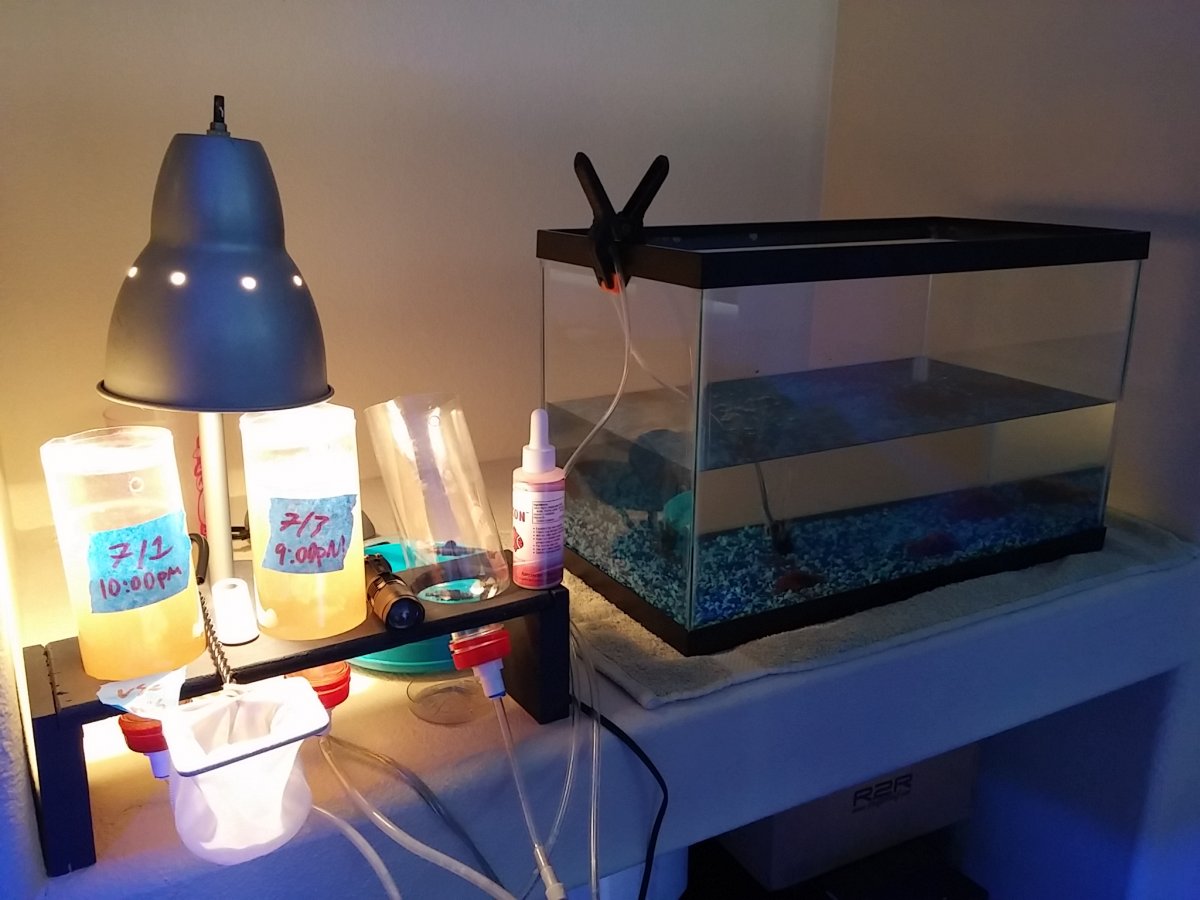
(My live food setup, the 10 gallon was a holding tank for blackworms)
For the first two weeks I feed Artemia heavily every 3 hours during the day. Once transferred to the grow-out tank I begin weaning them off life foods and onto either frozen or Reef Nutrition TDO. I start offer very small amounts of prepared foods and less and less of the Artemia and eventually they will switch over. I’ve had the best luck with frozen spirulina brine shrimp. Then once I have them eating prepared foods they are ready to be sold to local hobbyists or to the local fish store.
Introduction
The Banggai Cardinalfish or Pterapogon kauderni is a species of cardinalfish endemic to a small area of Central Sulawesi Indonesia around the coasts of 33 islands in the Banggai Archipelago. They are a striking, hardy, disease resistant fish making them a great choice for aquariums. They can be kept singly or in a mated pair as once sexually mature they are no longer tolerant of conspecifics. They are an excellent community fish leaving all other fish, coral and invertebrates alone and will even be hosted by long-spined sea urchins (Diadema antillarum) as well as various corals and anemones. Due to their demand, limited distribution in the wild, and the ease of raising their fry they are an excellent choice for captive breeding. They form non-monogamous pairs with the females willing to mate with multiple males. The following is my personal experience with breeding these amazing fish in my home aquarium over the past three years.
Getting a Mated Pair and Encouraging them to Breed
The Banggai Cardinalfish lacks any easily visible sexual dimorphism when young but develops some differentiating characteristics once mature such as males having a larger more “bull dog” looking mouth as well as growing longer second dorsal fins and broader pelvic fins. The easiest way for the average hobbyist to get a mated pair is to purchase 4-5 fish and let them form pairs on their own. Once you see a pair form you can re-home the remainder of fish. There is however another way. Between the pelvic and anal fins there will be either one or two small vents. Females having one vent and males having two. These vents are exceptionally hard to see when young but if you look closely you may be able to see them, feeding heavily will help the vents become more visible. Taking photos or video with a DSLR camera and macro lens can also help. See the photos below, single vent on the female (left) and two vents on the male (right).
There is no secret to getting them to breed. Give them a quality diet and an appropriately sized and maintained aquarium and they will reward you with a new fry every 2-4 weeks. When the female is ready to transfer the egg sack she starts following the male closely and starts vibrating on his side then on the other. While the male shows his readiness by flaring out his mouth. They will do this on and off for some time and then in a flash the egg sack is quickly fertilized and transferred to the safety of the males mouth.
The male will hold the eggs anywhere from 23-30 days and release anywhere from 10-20 fry at a time. Once the male is holding the eggs the female will become more territorial and protect the male. Even when the male is not holding the females tend to be more aggressive but when he is holding this behavior is exaggerated.
Collecting the Fry
When the male is close to releasing I put in a several fake sea urchins made of epoxy and zip tie clippings and remove mechanical filtration as well as making sure all pumps have foam guards to prevent fry from getting sucked into pumps. Alternatively you could somehow prevent them from entering the sump but all methods I tried restricted the flow and it was ultimately easier to just remove the socks and rescue any that ended up down there. You'll know he's close because you will see the little baby fish trying to push their way out of the male's mouth in the days before he lets them go as seen below.
The male will tend to release the fry in the hours before the lights turn on or just after they’ve turned off. The fry will tend to go to the sea urchins and especially the ones in lower flow areas. The sea urchins provide shelter from predatory fish and groups them together for you to easily collect. On several occasions I've turned the flow off and been able to just slowly lift the sea urchin up and the fry will travel up with the urchin, then I just put a net under and slowly lift them out, setting the fake urchin aside once out of the water.
(Fake sea urchins made of epoxy and zip tie clippings)
I check just after lights out, in the middle of the night if I'm up, and first thing in the morning every day until they are all released. Also, it's common for fry to be released over the course of a couple or a few days so don't assume he's empty until you see him eat again. As he releases them I snatch them up with a small net trying to damage as few corals as possible. A bright flashlight after lights out will be key with this method. And I put them into either a breeder net or a Tupperware with slits cut into it, just enough to provide some flow but not large enough for them to escape. I keep them in there for the first couple weeks or so before transferring to a 10 or 20 gallon of their own. While the fake sea urchin method is effective for display reef systems a dedicated breeding system for just the Banggai pair and their fry is obviously ideal.
(Baby Banggais with tiny Fungia corals in a Tupperware)
Feeding the Fry
Once released the fry will readily eat Artemia nauplii (Baby Brine Shrimp) and culturing them was the easiest way I found to keep the fry fed. It's important to note however that Artemia alone is not the best source of nutrition so you should enrich the Artemia with Selcon and its included HUFA's. The newborn fry will be prone to shock events known as “Sudden Fright Syndrome”. When shocked by the lights turning on or some other stressor they will sink to the bottom of the tank and lay on their side often times breathing heavy and will sometimes die from the ordeal. The supplementation of HUFA’s to their diet will decrease sudden fright syndrome occurrences and dramatically decrease or prevent mortality from those instances. In my case it was dramatic, before I started enriching I would lose 1-2 from each fry and have several sudden fright syndrome episodes. But early on I found out I could enrich the Artemia. After I started enriching my Artemia, I did not lose a single one for the remainder of the time I bred these fish and did not observe any episodes of sudden fright syndrome. Artemia will hatch in 12-24 hours depending on temperature, hatching faster when kept at a higher temperature. I found any standard 40w Incandescent bulb will produce adequate heat in my home. Artemia will be most nutritious in the first 12 hours after hatching when they still have their egg sacks attached but will need enrichment after that. For me it was easier to just enrich every batch on a set schedule.
(My live food setup, the 10 gallon was a holding tank for blackworms)
For the first two weeks I feed Artemia heavily every 3 hours during the day. Once transferred to the grow-out tank I begin weaning them off life foods and onto either frozen or Reef Nutrition TDO. I start offer very small amounts of prepared foods and less and less of the Artemia and eventually they will switch over. I’ve had the best luck with frozen spirulina brine shrimp. Then once I have them eating prepared foods they are ready to be sold to local hobbyists or to the local fish store.
Last edited:





